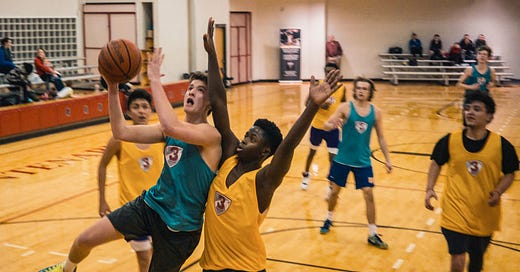Can Sport Enable Boys to Remain Competitive?
Boys are increasingly falling behind. Sport can help keep them in the game.

Alarming trends in the data indicate that boys are falling behind in many areas, most notably academic achievement. There are clear, persisting and indeed growing gaps in outcomes between boys and girls when it comes to high school grades and university admissions. School-age boys are also twice as likely as girls to be diagnosed with ADHD and the prevalence of ‘behavioural problems’ among boys are also more than double the reported rates for girls. The scale of the problem suggests that facets of the present school system are not conducive to success for boys. In lieu of system-wide changes in how schools operate, we need to come up with strategies and countermeasures to provide what is commonly lacking in the classroom experience and ensure that boys have what they need to thrive and be successful.
Understanding where the gaps are and what factors are not working in their favour is an important first step if we are to address or ameliorate the causes of the struggles that boys are facing.
There are significantly more women in the teaching profession and the disparity is greatest at the younger age groups. Male teachers make up less than a quarter of the overall number in public schools in the United States and only 1 in 10 teachers in elementary schools are male. Inevitably this increases the odds of some degree of gender bias in teachers’ expectations and treatment of students according to their sex. In such an environment, natural behaviours for juvenile males may be frowned upon or otherwise interpreted as misbehaviour. Boys may effectively find themselves penalised or otherwise admonished for not behaving more like girls.
It is not necessarily that boys are treated less favourably by teachers on an individual level. More commonly, it is simply that attitudes among teachers and administrators are less favourable towards traits and behaviours that are characteristic of young males. Illustrative examples include policies within schools that seek to restrict or exclude certain playground activities, most typically the types of play that boys choose to engage in. Competition in general is often regarded unfavourably in the school environment, prompting such measures as participation medals and the policy of not keeping score during matches. What this ignores is that juvenile males have an innate drive to compete and engage in physical contests with one another. When boys engage in social play it tends to be more physical. This type of rough and tumble play also plays a more significant role in the development process for young males.
The traits of being energetic and competitive are certainly not the exclusive domain of young males, but juvenile males are more adversely affected when they are not able to satisfy their need to be active and engage in physical play. The common observation that many boys have trouble sitting still for long periods is a feature not a bug! This helps to explain many of the behavioural issues, deficits in attentiveness and lack of engagement in class that are more commonly observed in boys.
A related alarming trend is the medicalisation of what are essentially normal juvenile male behaviours in certain parts of the world. For instance, there is compelling evidence that ADHD is overdiagnosed, raising the distinct possibility that a considerable number of those diagnosed with ADHD constitute false positives - not least as the diagnosis is often based on the reports of teachers and parents. What is hard to dispute is that pharmacological interventions are over-prescribed (most notably the US), especially as their side effects have the potential to impede normal development.
It has been speculated that a chronic lack of active play is contributing to the prevalance of ADHD symptoms in kids and certainly regular physical exercise and active play are highly efficacious in ameliorating this condition. It is well established that those diagosed with ADHD (the majority of whom are boys) fare better in the classroom when they are provided with breaks for exercise within the school day. More vigorous exercise of the type involved in sport is most efficacious, so we should helps kids to seek out opportunities to engage in this type of activity before, during and after the school day. Extracurricular sport is accordingly advocated as part of the management strategy to help kids diagnosed with ADHD.
Funnily enough the positive effects of regular exercise on behaviour, cognitive function and learning apply more generally with all kids. However, it is once again striking that the need and benefit seems most apparent for boys. Regular participation in extracurricular sport is associated with better engagement in class for kids aged 6-12 but this is especially the case with boys. This is similarly the case during the teenage years: the effect on cognitive outcomes of regular participation in sport and exercise is most pronounced among adolescent boys. Boys who participate in a sports team tend to have better grades at both middle school and high school level.
Beyond helping boys to focus and learn in the classroom, sport offers a space where they are permitted and encouraged to satisfy their innate drive to test themselves physically and compete with each other. In the process friendships are forged. Unlike girls, boys respond more favourably not only to team-mates but also opponents in the aftermath of a competition. By engaging in the contest boys earn each others’ admiration and respect. Through participating in sport boys are also more likely to find the role models and mentors that otherwise tend to be in short supply in the classroom environment. These individuals can serve an important role in helping to channel the focus and discipline that boys learn through sport into their academic studies.



